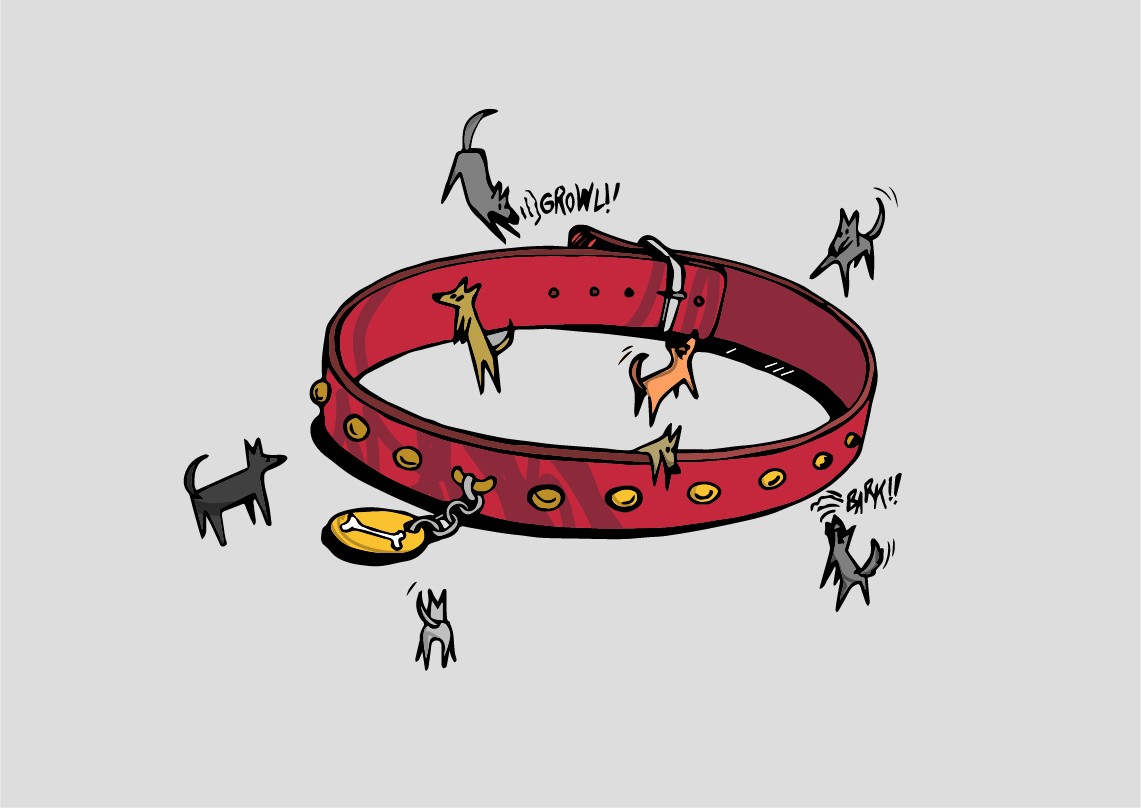

Body of IITR

For some time now, cases of individuals being hounded or bit by stray dogs within the campus have been piling up. A meeting of the ‘Dog Menace Committee’ was convened on the 15th of April to address these issues. Watch Out got in touch with Professor Gargi Singh and K.P. Singh, Chief Security Officer to cut through the noise and try to understand the measures taken, their degree of success and the impediments encountered in the same. A link to the minutes of the meeting of the Dog Menace Committee has been provided at the bottom. Readers are also encouraged to go through a previous article on the issue by WatchOut.
http://watchout.iitr.ac.in/2017/03/dogs-are-here-to-stay
They may be fuzzy, cuddly, floofy, smooshy balls of cotton candy or even scrawny, terrifying howling scoundrels, but the one uniting feature of all dogs is their need to gnaw and bite at anything they fancy, and as observed from the recent cases of dog bites reported in the campus, students are often at the receiving end. Dog bites are at the very core of the menace surrounding dogs. Fortunately, we haven’t had any cases of rabies - yet. Aggression amongst dogs is very frequent near certain perilous locations and depending on how unfortunate someone is, this aggression can quickly be directed towards them.
Another qualm that is voiced is how the presence of aggressive dogs effectively hijacks certain routes and forces pedestrians to take alternative paths. Seeing your favourite road being patrolled by a growling four-legged single-headed Cerberus that can outrun you (even if armed with Reebok’s Ultra Speed 2.0 Running shoes) is not quite appeasing.
The sight of trash strewn across the corridor, coupled with the mellow fragrance of poop in the air has been long been established to be not the best start to the day. And who wouldn’t want to share the water cooler with a pupper? The start of a new plague has never been easier.
“There are “good” dogs, there are “bad” dogs, I was bitten by a “bad” dog. I don’t want the campus to be dog-free, just we must have some kind of check on dogs.”
Spending a quality Sunday evening on the SAC discussion forum reveals how the student populace is fractured in their opinions about how to deal with our furry friends/adversaries. Some call for complete ousting of all dogs while some classify them as being ‘good’ and ‘bad’ and want the naughty ones to face the thunder. Another segment believes that a possible truce between the two species can be reached if the students are more cautious and compassionate in how they deal with these animals. Since dogs don’t have access to Eduroam’s password, their needs are posited by sympathizers who are soon labelled as ‘dog-lovers’. However, a pervading commonality across all such segments is an uproar that the administration is not taking sufficient measures to address the problem at hand.
“Every dog menace incident is dealt with”
Earlier, dogs that were identified as hell-raisers were thrown out of the campus, but it was soon found that displacing an animal from its place of birth was illegal; hence this measure had to be put on hold indefinitely.
According to AWBI (Animal Welfare Board of India) and WHO recommendations, sterilization is the most effective way of controlling the stray dog population. Adhering to the same, the administration invited “Human Society International” to start a sterilization drive across the campus which aimed to inhibit 125 dogs from breeding. The outcome of the drive was favourable in the short run - the number of dogs didn’t increase in the following mating season. However, in the next mating season, there was an unforeseen increment in their population. It was found out that only about 50% of the aimed dogs were actually sterilized in the drive earlier, leaving the rest to mate to their heart’s content.
“We fear what we don’t understand, and we destroy what we fear”
Animal Birth Control Programme: The second phase of sterilization has been initiated. Now, the dogs will be sterilised and vaccinated. A hard timeline has been set and is expected to be followed through (May 2019). The recently hired security agency has been instructed to carry out the sterilization drive in collaboration with RAAHAT NGO as their first job. Also, the dogs from outside the campus will be captured and pushed out of the campus boundaries. Any of the injured dogs will be taken to Dehradun for their proper treatment and possibly, adoption.
Identification of the dogs: According to a circular issued by the Animal Welfare Board of India, stray dogs cannot be beaten or driven away from their localities. They can however, be sterilised, immunized, and released back into the same area in accordance with the Animal Birth Control programme. The Dog Menace Committee, in their meeting on 15th April 2019, decided to use collar belts to distinguish between campus dogs and dogs that didn’t belong. On further deliberation, it was concluded that the campus dogs were smart enough to remove these collar belts. Instead, the identification of campus dogs is being done by cutting a ‘V’ shape on the ear lobe of the dogs. The stated procedure is internationally recognised. The dogs that will henceforward be identified as “new” can then be shown the door since their birthplace would not be within the walls of the campus.
Door to door garbage collection: The administration has taken measures to ensure door to door garbage collection from all the faculty families residing inside the campus. The waste food (especially non-vegetarian food) attracted dogs and nourished them. Dog menace has gone down in the areas where efficient garbage disposal systems are in place.
Securing the gates: Gates that are permanently shut see no influx of external dogs, it is the functional ones that let the dogs in. Keeping the same in mind, the Chief Security Officer has increased the security near the functional gates of the campus. The Institute Engineer has been actively working to resolve this problem and a change is expected to be visible soon.
Dog Shelters: The Nagar Nigam, upon the request of the administration, has planned to make a dog shelter around 5-8 km outside the campus. This shelter will harbour the castaway canines and will cater to all their needs.
In-Hostel Measures:
Ban on Feeding of Stray dogs inside the Hostel: This decision was taken keeping the students who fear dogs in mind. According to the administration, “If the dogs don’t get food in the hostel, they will go someplace else in search of food”.
Water coolers in Bhawans have been enclosed/raised to prevent dogs/monkeys drinking from them. Ceramic water bowls of Roorkee Cares will be placed around the campus. This measure is expected to safeguard the water coolers. Students and guards fill up these bowls every day.
The counsel of the Experts: Prof. Anindita Bindra (ISR Kolkata), a canine expert and researcher, is being called to the campus to present a neutral perspective. She will be talking to the Dean Administration, the Dog Menace Committee and will give a detailed analysis of what else needs to be done. A canine behaviourist from Norway is also being invited to do the same. Two canine trainers had been invited in the past as well. During their stay here, they conducted personality tests for dogs and identified them as ‘Skittish’, not ‘Aggressive’. Residents of IITR have been known to thrash dogs and this forms a big part of the reason why campus dogs are skittish.
Professor Gargi Singh started Roorkee Cares with the aim of caring for various animals in R-Land. They have rescued and helped dogs, squirrels, endangered birds etc. Campus junta is known to be engaged in the activities of Roorkee Cares. In Surat, the population of hell-raising dogs was culled by massive, large-scale poisoning. The city was soon tormented with the plague. Dogs keep the rodent population in check who in turn keep the snake population in check. Large scale killing of any species is harmful in the long run - we would do well to not mess with the ecosystem of any locality.
“Our dogs are Skittish, not Aggressive”
A Dog becomes skittish and aggressive for a host of reasons. It might be protecting its family and territory from trespassers, it might be scared, lonely, angry or it might just be having a bad day. However, it is also true that students do at times provoke and ill-treat them as well over prolonged periods of time. These dogs are usually very afraid of humans and tend to sprint, bite and run away when they happen to spot someone moving alone in their area.
This issue can be dealt with if the dogs are treated properly. The campus has a lot of therapeutic dogs – Mr. Chattu, Ms. (Mrs.?) Rampyari etc. that live harmoniously alongside the more evolved homo sapiens of the campus. They are properly taken care of and usually enjoy human company. It is possible to make the skittish stray dogs therapeutic as well by feeding and caring for them regularly, if their translocation encounters impenetrable hurdles.
The Dog Menace Committee meets every month, so any rule/initiatives which may have loopholes are expected to be revamped. Roorkee’s pup fiction will need an active contribution from the campus junta to have a happy and warm ending.
Minutes of Meeting of the Dog Menace Committee, 15th April 2019 (PDF)
